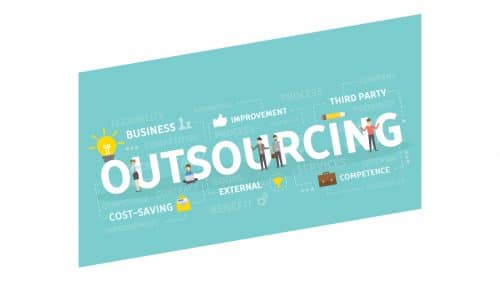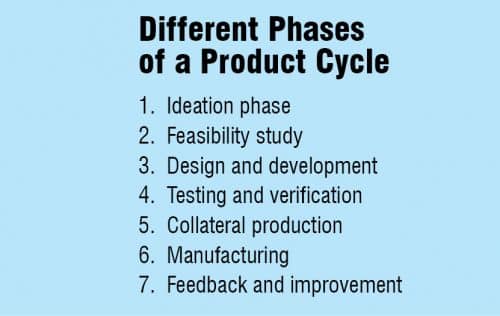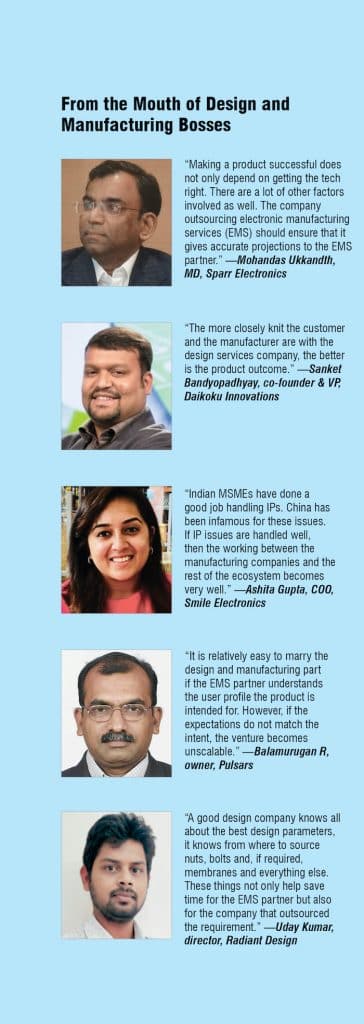There are several phases in the design and manufacture of a product, all of which are important, as outlined here. But to start with, if you are looking to outsource design and manufacture, please provide all the specs you desire in the product right in the beginning.
There is probably no electronics brand that has not thought of outsourcing designing or manufacturing, even both, to an independent partner. And why not, the advantages of the same range from less expenditure on R&D, hiring professionals and many other processes, but many a times, the fear of not being able to get the desired product outweighs these benefits.
If the fear were true, tech giant Apple would have never outsourced manufacturing of its world-famous iPhones to third parties. As a matter of fact, the company is now investing heavily in India, after China, where Apple’s contract manufactures include the likes of Foxconn, Wistron, and Pegatron. They have announced to put in close to US$900 million in India in the coming years!

It’s an inclusive art
There are companies that quickly want a reference design, get it manufactured and make a quick buck in a big market like India, or do a little work and export the product to other big markets and make some more money. On the other hand, there are companies who know that a product is merely not a product but a cycle that has the ability to keep end-consumers hooked not only to using the product but also wait in anticipation for the new variants of the same product to hit the market.
A typical product cycle, as per Sanket Bandyopadhyay, co-founder & VP, Daikoku Innovations, includes many phases (see box). He says the real improvement in the product comes after the manufacturing phase, and hence a company outsourcing the design and manufacture, or the design and manufacturing agency, should not consider the manufacturing phase as the final phase.
If you are looking to outsource design to a design house, you should provide them with all the specs you desire in the product right in the beginning. Adding specs down the line can hamper the advancements made in the design cycle. For example, if you wanted to source design of a compact looking electric vehicle charger that has the ability to fast charge also, you must specify whether your plans include deploying the same at homes or deploying the same on a commercial level. Imagine how big a mistake would it be if you got a charger designed for personal use while you wanted it for commercial use, or vice versa!

“There are some key stages in product development. Most of the challenges come in the ideation phase. The customer usually keeps adding new specs in the later stages, which makes things a lot difficult,” says Sanket.
The ideation phase matters a lot because this is where the design partners try to gauge the design challenges they would be facing to meet the set of certifications required for selling the product in different geographies. In case the company getting a product designed (new companies, generally) is uncertain about the certifications they would need, the design house should at least be provided with exact specs.
“The second most difficult phase after ideation is feasibility as this is where the existing patent infringement can take place. Then, in terms of importance, comes the testing phase. It is important because we have to make sure that all the specs submitted by a company for a product work perfectly,” added Sanket.
Constant feedback on the developments made by the design partner can help in cutting the amount of overall time required to take the product to its final stages. This is where both the company that has outsourced the requirement and the company working on the requirement have to play an equally important role. The former should keep checking about the developments while the latter should update the former about even the smallest of changes, issues, or implementations it has done.
“There is a saying in our industry, and it goes like this: Repeat orders make for perfect feedback. But to get those repeat orders we have to make sure that every phase in the product development is followed religiously. It is usually us, the design houses and the manufacturing partners, that have to remind customers about giving us feedback. It is as much your product as it is ours, and we need feedback to make it better for you,” says Mohandas Ukkandth, MD, Sparr Electronics.
A common example of the mismatch between the customer and design or manufacturing house can be found in wireless earbuds. Many of these hot-selling categories of smart wearables promise hours of battery life, but in actual conditions a lot of these fail to match what they promise.
Then comes the part where the two have to decide on the look and feel of the product. No matter how great a technical product you have developed, if it does not look and feel good, there are chances people will prefer your competitor over you. In the case of electronics, this look and feel is gauged by the quality of enclosure material used and how well the same has been saturated with the design and functionality of the product.
A great example of the same can be seen in the smartphones you use. Will you prefer to click images using a 100-megapixel camera embedded in a Chinese smartphone or a 12-megapixel camera embedded in an iPhone?
“The amount of time spent on finalising specs and other details, including the requirement of certifications, plays an important role in making any product successful. While outsourcing electronics design and manufacturing one should always remember that, while designing electronics is a simple process, the add-ons like plastic enclosures need a lot of focus and energy,” adds Mohandas.

Sanket adds, “The more closely knit the customer and the manufacturer are with the design services company, the better is the product outcome.”
Last but not the least is the user profile the product is intended for. While a lot of companies would hand over the specs to the design house and think that their work is done, some companies go an extra mile and tell the design house who exactly the product is intended for (the target audience). This would not only help the designer in suggesting what could be better, but it will give the contract manufacturing company an exact idea about the quality of materials to put into the product.
“It is relatively easy to marry the design and manufacturing part if the EMS partner understands the user profile the product is intended for. However, if the expectations do not match the intent, the venture becomes unscalable,” explains Balamurugan R, owner, Pulsars.
The requirements and ability
What if the design and manufacturing partner you intend to outsource to is very capable in producing small numbers but is not equipped to do well if large numbers are a part of the game? Or, what if the partner pays more attention to quantity than it does to detail?
Giving an example of European companies looking for design and manufacturing partners based in India, Balamurugan explains that Europeans prefer Indian manufacturing partners over Chinese when it comes to small quantities. But when it comes to larger quantities the same Europeans head to China or some other place.
“It is important both for the company outsourcing and the company accepting the outsourcing requirements to understand scale and requirements. Missing on this can prove to be a disaster for both,” according to Balamurugan.
He adds, “While there is big money in big orders, there also is big money in small orders. Our policies also need to be tuned to both big and small requirements. The combination of customers and design can do wonders if they are on the same page when it comes to matching the scale of requirements and the ability to get the work done.”
Saving time of a customer, whether Indian or foreign, is of paramount importance for a good design and manufacturing company. Uday Kumar, director, Radiant Design, believes a good partner, for getting repeat orders, makes sure that the product meets expectations, standards, and tech specs mentioned in the requirements.
The same happens when your manufacturing partner knows where to source components in bulk from. Whether it is a definite grade of plastic, a definite chip, or a definite type of screw that will be required to get the job done, your manufacturing partner should have a strong hold in the supply chain and know exactly from where and how he is going to source these elements.
“Electronics design is comparatively easier than designing a good-quality enclosure, and a good design company knows all about the best design parameters. It knows from where to source nuts, bolts and, if required, membranes and everything else. These things help save time and money for both the parties,” explains Uday.
How important is IPR?
Intellectual property rights (IPR) in the field of outsourcing electronics and design services are one of the most sensitive topics. A lot of companies interested in outsourcing design generally begin with the question that involves the process that the outsourcing partner follows for the IPR and what actually happens with the IPR of the product in question.
“IPR is the trust building part of the EMS business. Unlike China, where there is usually nothing called IPR, Indians are trusted much more than anybody else as far as IPR is concerned,” notes Sanket.
Ashita Gupta, COO, Smile Electronics, adds about the importance of IPR, “Indian MSMEs have done a good job handling IPs. China has been infamous for these issues. If IP issues are handled well, then working between the manufacturing companies and the rest of the ecosystem becomes easy.”
The design houses and companies outsourcing the needs could work on different models around IPR. One such model could be where the entire IPR gets transferred to the company who outsourced the requirement. This model will require the design house to design and develop a particular product and then transfer the IPR to the company that had given the order, before moving to the mass manufacturing phase. The other model, as explained by Sanket, could be the royalty based IPR model.

In the royalty model, the design organisation who developed the product keeps the IPR and bills the company in the form of royalty on the basis of every product they manufacture and sell based on that particular IPR. “Every product a company manufactures based on that particular IPR, the design company owning the IPR gets a royalty fee on that,” says Sanket.
The third model could be build, develop, and transfer mode. This model includes developing and running a product for an entire year and then shifting everything of that product, including the IPR, to the company that had given the order.
Mohandas explains that even when a company reaches out solely for the design part, it ends up getting the product manufactured from the design company in most of the cases. He says, it is critical for a design company to not give any reason to such customers to reach out to other companies for manufacture after the design part is over. That simply means that design and manufacturing houses are usually as concerned about the product development as you are.
If you are willing to secure your product copyrights even beyond the IPR, then non-disclosure agreements (NDAs) may be the answer. NDAs, as per Uday, can be used by customers to gain more confidence about outsourcing design and manufacturing. These are like promises and word of mouth sealed on a piece of paper cemented by the law, as per Uday.
But sometimes not getting into the IPR part can be rewarding too. If you do not own an IPR, or have not signed any kind of NDA with the design house, then following your relationship with the same you might get access to better versions of the same product over time. The best part is that this does not incur any additional charges than what you pay for manufacture. The design and manufacturing house wants to offer better versions, and now it wants to sell, so it will have to come to you and tell you that it has created a better version of the product you had suggested for it earlier.
“One advantage of not owning the IPR is the fact that customers get access to better versions of the same product without having to pay anything extra. He does not own any IPR, so he can easily switch to the better variants. The same has the potential to form long-term agreements between the two parties,” points out Balamurugan.
This story is based on a panel discussion that was a part of the February Edition of Tech World Congress. This panel was moderated by Arpit Chhabra, CEO, Iotfy.







